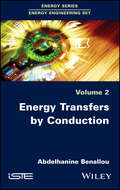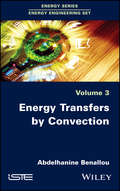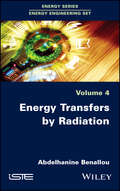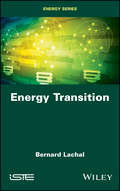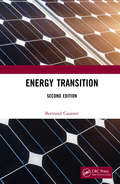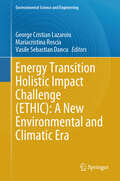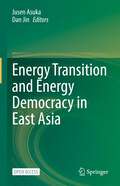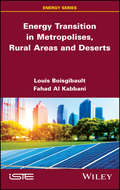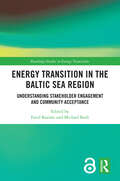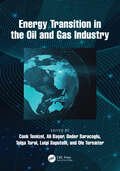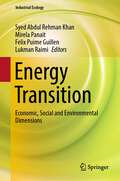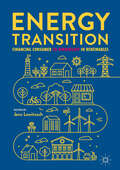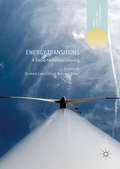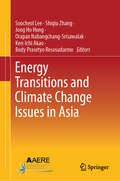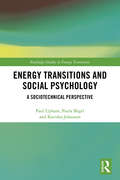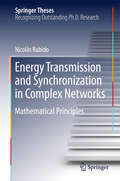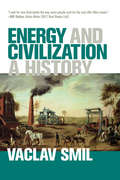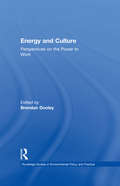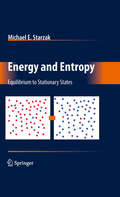- Table View
- List View
Energy Transfers by Conduction
by Abdelhanine BenallouWhile the topic of heat and mass transfer is an old subject, the way the book introduces the concepts, linking them strongly to the real world and to the present concerns, is particular. The scope of the different developments keeps in mind a practical energy engineering view.
Energy Transfers by Convection
by Abdelhanine BenallouWhether in a solar thermal power plant or at the heart of a nuclear reactor, convection is an important mode of energy transfer. This mode is unique; it obeys specific rules and correlations that constitute one of the bases of equipment-sizing equations. In addition to standard aspects of convention, this book examines transfers at very high temperatures where, in order to ensure the efficient transfer of energy for industrial applications, it is becoming necessary to use particular heat carriers, such as molten salts, liquid metals or nanofluids. With modern technologies, these situations are becoming more frequent, requiring appropriate consideration in design calculations. Energy Transfers by Convection also studies the sizing of electronic heat sinks used to ensure the dissipation of heat and thus the optimal operation of circuit boards used in telecommunications, audio equipment, avionics and computers.
Energy Transfers by Radiation
by Abdelhanine BenallouInside industrial furnaces and combustion chambers, energy is essentially exchanged by radiation. It is through the same mechanism that the energy emitted by the Sun spreads through different media to reach the Earth. Developing a sound understanding of the laws underlying energy exchanges by radiation is therefore essential, not only for establishing design equations for industrial equipment, but also for an optimal harvesting of solar energy and a better understanding of climate change phenomena such as the greenhouse effect. Energy Transfers by Radiation establishes the basic laws and equations which support the quantification of energy fluxes transferred between surfaces for situations similar to those usually encountered in industrial processes or in solar energy applications.
Energy Transition
by Bernard LachalAlthough most people are aware of the value of developing new energy technologies, the importance of assessing such technologies is only just beginning to be recognized in full. This book, illustrated by real-life examples, fulfils two main objectives. Firstly, it provides an in-depth summary of energy system evaluation methods, the result of decades of work in this area, for the use of researchers, engineers and anybody else interested in the energy sector. Secondly, the vicious cycle of neglect towards in situ evaluation is broken. This neglect is due to its unjust reputation for being “thankless work”: longwinded, expensive, difficult to exploit and undervalued. By scientifically organizing experience acquired over more than 30 years, Energy Transition highlights the considerable usefulness of the approach, not only economically, but also from a human standpoint.
Energy Transition
by Bertrand CassoretThis book presents both the importance of energy transition and its associated difficulties. Energy Transition, Second Edition, provides an explanation of the physical concepts of energy and power and also reviews global energy consumption and our dependence on energy. The book discusses the links between the economy and energy. It explains the drawbacks and dangers of different energy sources and tries to compare them. By reviewing future energy resources, it evaluates several transition scenarios. The book shows that the laws of physics prevent the emergence of simple, pleasant solutions, but it proposes potential solutions and encourages readers to develop better processes from energy sources to production to consumption. This book will be of interest to engineers and undergraduate and graduate students studying and working in various fields of energy; producers of fossil, gas, oil, coal, electric, renewable, and nuclear energy; and anyone interested in better understanding these fundamental problems for our future. FEATURES Discusses the current issues with energy transition Covers several energy transition scenarios and their associated difficulties Presents the links between economy and energy Highlights the importance of a global discussion of energy Encourages the development of better, improved processes in energy sources from production to consumption
Energy Transition Holistic Impact Challenge (Environmental Science and Engineering)
by George Cristian Lazaroiu Mariacristina Roscia Vasile Sebastian DancuThis book states that the new environmental challenge will also have to be faced ethically, science can provide the tools, but people will have to be sensitized so that they make their own environmental ethics. The challenge of the new era is: the environment and therefore the climate, as it does not start outside of us, but as a constituent element of our life and therefore lived ethically. The new vision proposed in this book is to push technology together with the human being, in assuming environmentally ethical behaviors: this is the greatest collective action of humanity. Sustainable development has allowed an integrated key to the social, economic, and environmental dimensions. Through ethics, sustainability can be combined not only by referring to the problem of pollution and the exploitation of natural resources, but it creates a new global era that includes all dimensions of people's lives and of society. The shared and structured environmental ethics allow an approach that is no longer short-term but provide the collective tools to look far in time. With this book, we want to lay the instrumental, technical, social, and legislative foundations, to provide a new methodology for the care of the environment, as up to now, there has been much discussion, but little achieved in a truly ethical way.
Energy Transition and Energy Democracy in East Asia
by Jusen Asuka Dan JinThis is an open access book.The subject of this book is to provide down-to-earth information on what kind of actions are being taken by the Government, Local community, Businesses, Researchers, NGOs on the energy transition in this region. It gives an updated picture of the energy transition in the East Asian countries, where the economic growth, as well as CO2 emission growth, is significant.This book focuses not only on the technological perspective of the energy transition but also on the relationship between democracy and energy transition. Readers of this book can understand what kind of international support and pressure is needed to promote the energy transition in this region.Since energy transition is needed not only for combatting climate change but also for the Green Recovery from the COVID-19 pandemic, publishing this book is very helpful to promote the Green Recovery and the Green New Deal world-widely.
Energy Transition in Brazil (The Latin American Studies Book Series)
by Drielli Peyerl Stefania Relva Vinícius Da SilvaThe book's objective is to present the energy transition process in Brazil over time and offer new perspectives on this process in the eyes of a sustainable future. The book unfolds over 15 chapters covering historical, geopolitical, technological, and economical aspects, as well as aspects conceptually familiar to the energy transition such as public perception, low-carbon technologies, digitalization, Sustainable Development Goals, and even recent topics such as the pandemic of COVID-19. The Brazilian electricity and transport sectors and climate change governance are the main focus of this book. The paths taken throughout this book demonstrate the particularities of Brazil and present this country in a unique and differentiated way in terms of the various approaches to the energy transition. It is a book that brings a multidisciplinary, innovative vision and information published for the first time.
Energy Transition in Metropolises, Rural Areas, and Deserts
by Louis Boisgibault Fahad Al KabbaniEnergy Transition in Metropolises, Rural Areas and Deserts presents detailed field studies of energy transition in Lille, Riyadh, Fayence, Bokhol, Ouarzazate and the Arabian Desert. It analyzes local actions and good practices – according to the resources and constraints involved – in the process of removing the obstacles to the transition. Solutions are sought for the right type of space for buildings, transport, industry and services, and targets are set for Europe, the Middle East and Africa as part of the Paris Climate Agreement. As a pedagogical tool, this book is aimed at not only politicians and professionals, but also any members of the public who wish to learn about changes in production and energy consumption.
Energy Transition in the Baltic Sea Region: Understanding Stakeholder Engagement and Community Acceptance (Routledge Studies in Energy Transitions)
by Farid Karimi and Michael RodiThis book analyses the potential for active stakeholder engagement in the energy transition in the Baltic Sea Region (BSR) in order to foster clean energy deployment. Public acceptability and bottom-up activities can be critical for enduring outcomes to an energy transition. As a result, it is vital to understand how to unlock the potential for public, community and prosumer participation to facilitate renewable energy deployment and a clean energy transition – and, consequently, to examine the factors influencing social acceptability. Focussing on the diverse BSR, this book draws on expert contributions to consider a range of different topics, including the challenges of social acceptance and its policy implications; strategies to address challenges of acceptability among stakeholders; and community engagement in clean energy production. Overall, the authors examine the practical implications of current policy measures and provide recommendations on how lessons learnt from this ‘energy lab region’ may be applied to other regions. Reflecting an interdisciplinary approach in the social sciences, this book is an essential resource for scholars, students and policymakers researching and working in the areas of renewable energy, energy policy and citizen engagement, and interested in understanding the potential for bottom-up, grassroots activities and social acceptability to expedite the energy transition and reanimate democracies.
Energy Transition in the Oil and Gas Industry
by Luigi Saputelli Cenk Temizel Ole Torsæter Ali Başer Onder Saracoglu Tolga TuralThe oil and gas industry is in the midst of a paradigm shift, moving from developing solely petroleum-based energy to producing alternative energy forms, including renewables. Energy Transition in the Oil and Gas Industry offers a comprehensive overview of renewables and their applications in the oil and gas industry during the current energy transition period. It includes the latest methods and workflows in renewables and oil and gas processes as well as integrated and hybrid approaches currently used as the industry begins its transition to the production of alternative forms of energy. Provides a synopsis of fossil fuel resources, along with the latest technologies, applications, and economics, and offers a general outline for the energy transition Details various alternative and renewable energy forms and discusses their advantages, disadvantages, maturity levels, and applications, including solar, geothermal, wind, hydropower, fuel cells, hydrogen, biofuels, ocean energy, and nuclear Discusses carbon capture and storage, electric vehicles, and energy storage technologies Covers the latest advances and technologies related to digital transformation in the oil and gas industry Summarizes future trends and directions of technologies related to renewable energy and energy transition in the oil and gas industry Addressing energy holistically from a technology and engineering perspective, this book offers engineering professionals in the energy sector a wide-ranging view of current and near future changes taking place in this critical industry.
Energy Transition: Economic, Social and Environmental Dimensions (Industrial Ecology)
by Syed Abdul Rehman Khan Mirela Panait Felix Puime Guillen Lukman RaimiThis book opens up a critical dimension of energy transition taking in account multidimensional challenges on economic, social and environmental fields. The book discusses the trends in the field of energy transition and evolving practices adopted by public authorities and companies for betterment of environment and society. The editors (4) identify directions and challenges involved in the energy transition. The novelty of this book is the multidisciplinary approach, being presented the economic, social and environmental challenges involved in the energy transition. The energy transition is accompanied by a complex process of changing attitudes and behaviors of energy consumers and producers. The consequences are profound not only economically and environmentally but also socially, renewable energy being a solution for energy poverty reduction and development of rural communities. Therefore, certain social and environmental problems generated by energy poverty are solved by using renewable energy. Moreover, the complexity of the phenomenon is presented not only in terms of the analysis of the main sources of renewable energy but also the ethical aspects involved in the use of sources such as biofuels. In the case of this source, the main problem is whether the use of certain agricultural products for the production of biofuels threatens food security, especially in rural areas. All categories of stakeholders must show responsibility and get involved in this complex process which requires a remarkable technical and financial effort. The energy transition can offer innovative solutions through which the impact of economic activity on the environment is minimized, and in this way, industrial ecology achieves its objectives to support sustainable development. The demands imposed by industrial ecology must shape not only the behavior of oil and gas companies but also of entities involved in the production and consumption of renewable energy. Given the negative externalities generated, companies in the fossil fuel sector have become increasingly socially responsible, their social and environmental performance (non-financial) being presented in detail in the annual sustainability reports to inform stakeholders. Therefore, this book is an important read not only for scholars, but also for those who are interested in ensuring an environmentally sustainable future taking in account energy transition challenges.
Energy Transition: Financing Consumer Co-Ownership in Renewables
by Jens LowitzschConsumer (co-)ownership in renewable energy (RE) is essential to the overall success of Energy Transition. In June 2018, the European Union agreed on a corresponding enabling framework as part of a recast of the Renewable Energy Directive (RED II). The transposition of these comprehensive rules – in particular those on local RE communities – requires developing, implementing and rolling out business models that broaden the capital participation of consumers. The challenge is to include municipalities and/or commercial investors like SMEs and advance to economies of scale while retaining the benefits of individual consumer participation.This book is addressed to energy consumers in local communities, their municipalities and to the policy makers who represent them. Additionally, non-EU countries, in particular those where rural areas have limited access to energy, e.g. in Asia, Africa and Latin America, may be interested in the benefits of consumer ownership. While demand for energy in developing countries is growing, access to energy is crucial for improving the quality of life. The editor of this book presents a new model of consumer ownership in RE for both the EU and countries worldwide. Part One describes the rationale for consumer ownership in RE with regard to social, organizational, legal and financial conditions. Part Two discusses the issue of financing RE and introduces a new financing technique, the Consumer Stock Ownership Plan (CSOP), comparing it to traditional models. Part Three provides 18 country studies from Europe, North America, South America and Asia, organized so as to enable a cross-country comparison of policy approaches and feasibility. Policy recommendations are based on the results of this survey. Part Four summarizes, compares the best practice cases, presents a cost-benefit analysis of “prosumage” and against this background evaluates the impact on future policy.
Energy Transitions
by Alain Nadaï Olivier LabussièreThis book elucidates what it means to transition to alternative sources of energy and discusses the potential for this energy transition to be a more democratic process. The book dynamically describes a recent sociotechnical study of a number of energy transitions occurring in several countries - France, Germany and Tunisia, and involving different energy technologies - including solar, on/off-shore wind, smart grids, biomass, low-energy buildings, and carbon capture and storage. Drawing on a pragmatist tradition of social inquiry, the authors examine the consequences of energy transition processes for the actors and entities that are affected by them, as well as the spaces for political participation they offer. This critical inquiry is organised according to foundational categories that have defined the energy transition - ‘renewable’ energy resources, markets, economic instruments, technological demonstration, spatiality (‘scale’) and temporality (‘horizon(s)’). Using a set of select case studies, this book systematically investigates the role these categories play in the current developments in energy transitions.
Energy Transitions and Climate Change Issues in Asia
by Soocheol Lee Ken-Ichi Akao Budy Prasetyo Resosudarmo Shiqiu Zhang Jong Ho Hong Orapan Nabangchang-SrisawalakThe rapid pace of economic development and urbanization in Asia have led to several major problems such as greenhouse gas emissions, mass consumption, and depletion of natural resources. These problems pose a major threat to a sustainable future for Asia and are hindering many Asian countries' goal of becoming carbon-neutral by the middle of this century. Solving these problems requires a comprehensive understanding of the nature of energy consumption, exploitation of natural resources, and deterioration of the environment.To accelerate the green energy transition and promote efficient resource use in Asia, a range of policy options and joint efforts among Asian countries will be required, including carbon pricing, resource tax reform, the expansion of transition finance, support for the development of low-carbon, and resource-efficient social infrastructure. However, Asia is home to many countries, each in a different stage of economic development and with its own culture and customs. Practical implementation of these policies will require bringing together researchers, policymakers, and citizens to share their knowledge and engage in discussions to generate policy ideas that are appropriate for each country. The purpose of this book is to share theoretical and empirical knowledge and convey policy implications that can be expected to accelerate energy transition and resource use effectiveness toward a sustainable future in Asia.
Energy Transitions and Social Psychology: A Sociotechnical Perspective (Routledge Studies in Energy Transitions)
by Paul Upham Paula Bögel Katinka JohansenThis book explains how social psychological concepts can be closely integrated with sociotechnical perspectives of energy transitions. It shows the value of actor-centred analysis that acknowledges the role of individual-level processes within their wider contexts of energy supply and use. In this way, the book connects social psychological and sociological frames of analysis, preserving the value of both, to provide multi-level, analytically extended accounts of energy transitions processes. Sociotechnical thinking is about the interactions of people and technology, including the rules, regulations and institutions involved. Such perspectives help to identify the many forms of path dependency that can make change difficult. Human behaviour plays a strong role in maintaining these path dependencies, but it can also introduce change. This book advocates a deliberately interdisciplinary research agenda that recognises the value of social psychological perspectives when seeking to create new pathways for energy supply and use. At the same time, it also demonstrates the value of sociotechnical perspectives for energy-related social psychology. Energy Transitions and Social Psychology will be of great interest to students and scholars of energy transitions, environmental and energy psychology, sustainable development and innovation studies, as well as students and scholars of environment and energy more generally.
Energy Transmission and Synchronization in Complex Networks
by Nicolás RubidoThis work tackles the problems of understanding how energy is transmitted and distributed in power-grids as well as in determining how robust this transmission and distribution is when modifications to the grid or power occur. The most important outcome is the derivation of explicit relationships between the structure of the grid, the optimal transmission and distribution of energy, and the grid's collective behavior (namely, the synchronous generation of power). These relationships are extremely relevant for the design of resilient power-grid models. To allow the reader to apply these results to other complex systems, the thesis includes a review of relevant aspects of network theory, spectral theory, and novel analytical calculations to predict the existence and stability of periodic collective behavior in complex networks of phase oscillators, which constitute a paradigmatic model for many complex systems.
Energy Works
by Janette SchusterNIMAC-sourced textbook <p><p> Energy Works allows students to explore different kinds of energy and see how energy is converted to different forms.
Energy Works: Below-Grade Reader (Building Blocks of Science Literacy Series)
by Janette SchusterLexile range: 520L–670L. Energy Works Below-Grade Reader encourages students to consider energy in all its different forms. Topics include: Energy and Its Forms; Energy Sources; the Science and Engineering Practices of analyzing data; and a look into the daily life of an electrical engineer.
Energy and Civilization: A History (The\mit Press Ser.)
by Vaclav SmilA comprehensive account of how energy has shaped society throughout history, from pre-agricultural foraging societies through today's fossil fuel–driven civilization."I wait for new Smil books the way some people wait for the next 'Star Wars' movie. In his latest book, Energy and Civilization: A History, he goes deep and broad to explain how innovations in humans' ability to turn energy into heat, light, and motion have been a driving force behind our cultural and economic progress over the past 10,000 years.—Bill Gates, Gates Notes, Best Books of the YearEnergy is the only universal currency; it is necessary for getting anything done. The conversion of energy on Earth ranges from terra-forming forces of plate tectonics to cumulative erosive effects of raindrops. Life on Earth depends on the photosynthetic conversion of solar energy into plant biomass. Humans have come to rely on many more energy flows—ranging from fossil fuels to photovoltaic generation of electricity—for their civilized existence. In this monumental history, Vaclav Smil provides a comprehensive account of how energy has shaped society, from pre-agricultural foraging societies through today's fossil fuel–driven civilization. Humans are the only species that can systematically harness energies outside their bodies, using the power of their intellect and an enormous variety of artifacts—from the simplest tools to internal combustion engines and nuclear reactors. The epochal transition to fossil fuels affected everything: agriculture, industry, transportation, weapons, communication, economics, urbanization, quality of life, politics, and the environment. Smil describes humanity's energy eras in panoramic and interdisciplinary fashion, offering readers a magisterial overview. This book is an extensively updated and expanded version of Smil's Energy in World History (1994). Smil has incorporated an enormous amount of new material, reflecting the dramatic developments in energy studies over the last two decades and his own research over that time.
Energy and Conflict: The Life and Times of Edward Teller
by Stanley Blumberg Gwinn OwensHere is the first biography of Edward Teller, based on exclusive access to the man and the archives. This is the life story of perhaps the most controverisal and certainly one of the greatest nuclear physicists of the twentieth century. widely known as the father of the hydrogen bomb, Teller was a genius among giants in the scientific community, his career coterminus with the nuclear age. His controversy with Robert Oppenheimer, here updated, constitutes one of the dramatic high points of the Cold War, in which Teller has been an absolutely crucial figure.
Energy and Culture: Perspectives on the Power to Work (Routledge Studies in Environmental Policy and Practice)
by Brendan DooleyHow will humanity continue to meet its energy needs without destroying the conditions necessary to sustain human life on earth? The search for an answer to this question depends as much on the past as on the present; and as much on the physical sciences as on the social sciences. This book offers a truly trans-disciplinary and trans-cultural look at the problem of energy production and consumption in modern times. Discussing issues of history, politics, science, risk, lifestyle and representation, contributors demonstrate that experiences through time can provide insights into the kinds of solutions that have succeeded, as well as reasons why other solutions have failed. They also show what different countries and cultures might learn from each other, emphasizing how discoveries in one discipline have inspired new approaches in another discipline. Among many other important conclusions, the book suggests that energy transitions do not occur simply because of the exhaustion of old energy sources, and any solutions to the incipient energy crisis of the 21st century will depend on people's perceptions of science, environment and risk, informed and shaped in turn by the media.
Energy and Electromagnetism
by Lawrence Hall of Science University of California at BerkeleyNIMAC-sourced textbook
Energy and Entropy
by Michael E. StarzakThis book presents the various branches of thermodynamics - classical, statistical, and others - and kinetics in a lucid manner that will appeal both to advanced undergraduates and beginning graduate students. The mathematical treatment is neither overly elaborate nor absent, but has been illustrated by examples from biology, physics, and other disciplines. The models drawn from diverse areas should make it attractive to readers seeking a clearer physical understanding of these fields and how they interrelate. Features include: worked examples exercises solutions to some of the exercises, available to all readers solutions to all the exercises, available to instructors.
